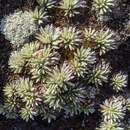pms
nòm ant ël fil


Celmisia saxifraga, commonly known as the small snowdaisy, is a perennial herb in the Asteraceae family. It is native to Tasmania and Victoria, where it grows in alpine grasslands above the snowline.[3]
Like other members of the Asteraceae family, C. saxifraga has a composite flower head with both disk and ray florets.[4] Inflorescence are a typical daisy arrangement with white outsides and a yellow centre. The entire inflorescence can be 3 cm across, and is often held well above the rosette on a hairy stem growing to 15 cm.[5] The fruit is small, hard, and dry, similar to a sunflower seed.[6] This is often called an achene, but in Asteraceae is more accurately called a cypsela. [7] The primary difference between the two being that a cypsela is a single fruit formed from two ovaries (as in C. saxifraga) while an achene describes a fruit formed from a single ovary.[8] The leaves of C. saxifraga are simple and entire, growing to 3 cm long. They are glaucous silver and hairy.[9] C. saxifraga can be distinguished from the similar and co-occurring C. asteliifolia by its leaves.[10] The leaves of C. saxifraga are shorter (~3 cm) than those of C. asteliifolia (up to 18 cm).[11]
"Saxifraga" is a combination of the Latin words saxum, meaning "stone", and frangere meaning "to break". The name "stone-breaker" is however thought to refer to plant in the genus Saxifraga being used in treating kidney stones.[12] It is unclear whether C. saxifraga is named for breaking rocks or for its similarity to certain Saxifraga species which are also herbaceous and rosette-forming.
Celmisia saxifraga, commonly known as the small snowdaisy, is a perennial herb in the Asteraceae family. It is native to Tasmania and Victoria, where it grows in alpine grasslands above the snowline.